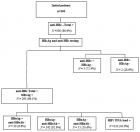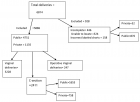Abstract
Research Article
The Combinatory Effects of Zinc Oxide Nanoparticles (ZnO NPs) and Thiamine on Skin of Alloxan-Induced Diabetic Mice; a Stereological and Biochemical Study
Rahmat Allah Fatahian Dehkordi*, Sekineh Pasalar, Saied Habibian Dehkordi and Bahnaz Karimi
Published: 03 July, 2023 | Volume 7 - Issue 1 | Pages: 018-027
This study aimed to investigate the treatment effects of ZnO NPs plus thiamine on histo-stereological and biochemical parameters in diabetic mouse skin. In total 54 BALB/C mice were used and divided into nine groups. Twenty-four mice were coordinately assigned as control groups (I), thiamine (II), and zinc oxide nanoparticles (III and IV; 1.0 and 5.0 mg/kg). Diabetes was induced in the remaining rats with a dose of 180 mg/kg of alloxan; diabetes group (group V). Other diabetic mice were treated with ZnO NPs (0.1 and 0.5 mg/kg) alone (groups VI and VII, respectively) and along with thiamine (groups VIII and IX, respectively). An increase in weight was observed in the diabetic group compared to the control group. Diabetic skin showed decreasing in volume density of collagen bundles and decreasing in the epidermis and dermis thickness, as well as an increase in the hypodermis's thickness. Administration of ZnO NPs (0.1 and 0.5 mg/kg) alone and along with thiamine in the diabetic animals resulted in anti-hyperglycemic activity, reducing GGT, BUN, Cr, MDA, and NO levels in treated diabetic mice. In conclusion, the concomitant use of ZnO NPs along with thiamine presents the potential as a combination therapy for the treatment of alloxan-induced diabetic mice skin changes.
Read Full Article HTML DOI: 10.29328/journal.adr.1001026 Cite this Article Read Full Article PDF
Keywords:
Diabetes; Mice; Skin; Thiamine; ZnO NPs
References
- Mahan LK, Escott-Stump S. Krause's food, nutrition, & diet therapy, Saunders Philadelphia, 2004.
- Report of the Expert Committee on the Diagnosis and Classification of Diabetes Mellitus. Diabetes Care. 1997 Jul;20(7):1183-97. doi: 10.2337/diacare.20.7.1183. PMID: 9203460.
- Amiri A, Dehkordi RAF, Heidarnejad MS, Dehkordi MJ. Effect of the Zinc Oxide Nanoparticles and Thiamine for the Management of Diabetes in Alloxan-Induced Mice: a Stereological and Biochemical Study. Biol Trace Elem Res. 2018 Feb;181(2):258-264. doi: 10.1007/s12011-017-1035-x. Epub 2017 May 22. PMID: 28534098.
- Ahmadi A, Hasanzadeh J, Rahimi Madiseh M, Lashkari L. Effective factors in the quality of life in patients with type 2 diabetes in Chaharmahal & Bakhteyari Province. Journal of north Khorasan University of medical sciences. 2011; 3:7-13.
- Taylor KR, Costanzo AE, Jameson JM. Dysfunctional γδ T cells contribute to impaired keratinocyte homeostasis in mouse models of obesity. J Invest Dermatol. 2011 Dec;131(12):2409-18. doi: 10.1038/jid.2011.241. Epub 2011 Aug 11. PMID: 21833015; PMCID: PMC3213272.
- Chen X, Lin W, Lu S, Shi Y, Zou J, Liu Z, Liao W. Insulin prevents latent skin lesions by inhibiting the generation of advanced glycation end products in streptozotocin-induced diabetic rats. Endocr Pathol. 2009 Fall;20(3):163-9. doi: 10.1007/s12022-009-9084-0. PMID: 19488861.
- Cavallini M. Autologous fibroblasts to treat deep and complicated leg ulcers in diabetic patients. Wound Repair Regen. 2007 Jan-Feb;15(1):35-8. doi: 10.1111/j.1524-475X.2006.00182.x. PMID: 17244317.
- Schmidt-Mende L, MacManus-Driscoll JL. ZnO–nanostructures, defects, and devices, Materials today. 2007; 10:40-48.
- Odendaal JP, Reinecke AJ. Quantitative assessment of effects of zinc on the histological structure of the hepatopancreas of terrestrial isopods. Arch Environ Contam Toxicol. 2007 Oct;53(3):359-64. doi: 10.1007/s00244-006-0080-9. Epub 2007 Jul 4. PMID: 17612782.
- Juzenas P, Chen W, Sun YP, Coelho MA, Generalov R, Generalova N, Christensen IL. Quantum dots and nanoparticles for photodynamic and radiation therapies of cancer. Adv Drug Deliv Rev. 2008 Dec 14;60(15):1600-14. doi: 10.1016/j.addr.2008.08.004. Epub 2008 Sep 20. PMID: 18840487; PMCID: PMC2695009.
- Rzigalinski BA, Strobl JS. Cadmium-containing nanoparticles: perspectives on pharmacology and toxicology of quantum dots. Toxicol Appl Pharmacol. 2009 Aug 1;238(3):280-8. doi: 10.1016/j.taap.2009.04.010. Epub 2009 Apr 18. PMID: 19379767; PMCID: PMC2709954.
- Li J, Guo D, Wang X, Wang H, Jiang H, Chen B. The Photodynamic Effect of Different Size ZnO Nanoparticles on Cancer Cell Proliferation In Vitro. Nanoscale Res Lett. 2010 Apr 16;5(6):1063-71. doi: 10.1007/s11671-010-9603-4. PMID: 20671778; PMCID: PMC2893699.
- Heinlaan M, Ivask A, Blinova I, Dubourguier HC, Kahru A. Toxicity of nanosized and bulk ZnO, CuO and TiO2 to bacteria Vibrio fischeri and crustaceans Daphnia magna and Thamnocephalus platyurus. Chemosphere. 2008 Apr;71(7):1308-16. doi: 10.1016/j.chemosphere.2007.11.047. Epub 2008 Jan 14. PMID: 18194809.
- Chu D, Gao J, Wang Z. Neutrophil-Mediated Delivery of Therapeutic Nanoparticles across Blood Vessel Barrier for Treatment of Inflammation and Infection. ACS Nano. 2015 Dec 22;9(12):11800-11. doi: 10.1021/acsnano.5b05583. Epub 2015 Nov 5. PMID: 26516654; PMCID: PMC4699556.
- Siddiqui SA, Or Rashid MM, Uddin MG, Robel FN, Hossain MS, Haque MA, Jakaria M. Biological efficacy of zinc oxide nanoparticles against diabetes: a preliminary study conducted in mice. Biosci Rep. 2020 Apr 30;40(4):BSR20193972. doi: 10.1042/BSR20193972. PMID: 32207527; PMCID: PMC7138905.
- Fattal I, Friedmann N, Fattal-Valevski A. The crucial role of thiamine in the development of syntax and lexical retrieval: a study of infantile thiamine deficiency. Brain. 2011 Jun;134(Pt 6):1720-39. doi: 10.1093/brain/awr068. Epub 2011 May 9. PMID: 21558277.
- Tunc-Ozdemir M, Miller G, Song L, Kim J, Sodek A, Koussevitzky S, Misra AN, Mittler R, Shintani D. Thiamin confers enhanced tolerance to oxidative stress in Arabidopsis. Plant Physiol. 2009 Sep;151(1):421-32. doi: 10.1104/pp.109.140046. Epub 2009 Jul 29. PMID: 19641031; PMCID: PMC2735988.
- Singleton CK, Martin PR. Molecular mechanisms of thiamine utilization. Curr Mol Med. 2001 May;1(2):197-207. doi: 10.2174/1566524013363870. PMID: 11899071.
- Rapala-Kozik M. Vitamin B1 (Thiamine): a cofactor for enzymes involved in the main metabolic pathways and an environmental stress protectant, Advances in botanical research. Elsevier. 2011; 37-91.
- Bâ A. Metabolic and structural role of thiamine in nervous tissues. Cell Mol Neurobiol. 2008 Nov;28(7):923-31. doi: 10.1007/s10571-008-9297-7. Epub 2008 Jul 19. PMID: 18642074.
- Rodríguez-Martín JL, Qizilbash N, López-Arrieta JM. Thiamine for Alzheimer's disease. Cochrane Database Syst Rev. 2001;(2):CD001498. doi: 10.1002/14651858.CD001498. PMID: 11405995.
- Fatahian Dehkordi RA, Moradi H. Stereological estimation and morphological assessment of the endocrine pancreatic components in relation to sex in hen. Vet Res Forum. 2015 Winter;6(1):49-54. Epub 2015 Mar 15. PMID: 25992251; PMCID: PMC4405685.
- Inuwa IM. First-order stereology in diabetes and endocrine research-number and volume estimation of objects. International journal of Diabetes and Metabolism. 2005; 13:10.
- Ayala A, Muñoz MF, Argüelles S. Lipid peroxidation: production, metabolism, and signaling mechanisms of malondialdehyde and 4-hydroxy-2-nonenal. Oxid Med Cell Longev. 2014;2014:360438. doi: 10.1155/2014/360438. Epub 2014 May 8. PMID: 24999379; PMCID: PMC4066722.
- Yazdi HB, Hojati V, Shiravi A, Hosseinian S, Vaezi G, Hadjzadeh MA. Liver Dysfunction and Oxidative Stress in Streptozotocin-Induced Diabetic Rats: Protective Role of Artemisia J Pharmacopuncture. 2019 Jun;22(2):109-114. doi: 10.3831/KPI.2019.22.014. Epub 2019 Jun 30. PMID: 31338251; PMCID: PMC6645339.
- Kalugalage T, Rodrigo C, Vithanage T, Somaratne P, De Silva HJ, Handunnetti S, Rajapakse S. Low serum total nitrite and nitrate levels in severe leptospirosis. BMC Infect Dis. 2013 May 6;13:206. doi: 10.1186/1471-2334-13-206. PMID: 23648003; PMCID: PMC3651868.
- Syal K, Srinivasan A, Banerjee D. Streptomycin interference in Jaffe reaction - possible false positive creatinine estimation in excessive dose exposure. Clin Biochem. 2013 Jan;46(1-2):177-9. doi: 10.1016/j.clinbiochem.2012.10.031. Epub 2012 Oct 31. PMID: 23123914.
- Ahmed F, Husain Q, Ansari MO, Shadab G. Antidiabetic and oxidative stress assessment of bio-enzymatically synthesized zinc oxide nanoformulation on streptozotocin-induced hyperglycemic mice. Applied Nanoscience. 2020; 10:879-893.
- Bayrami A, Parvinroo S, Habibi-Yangjeh A, Rahim Pouran S. Bio-extract-mediated ZnO nanoparticles: microwave-assisted synthesis, characterization and antidiabetic activity evaluation. Artif Cells Nanomed Biotechnol. 2018 Jun;46(4):730-739. doi: 10.1080/21691401.2017.1337025. Epub 2017 Jun 15. PMID: 28617629.
- Virgen-Ortiz A, Apolinar-Iribe A, Díaz-Reval I, Parra-Delgado H, Limón-Miranda S, Sánchez-Pastor EA, Castro-Sánchez L, Jesús Castillo S, Dagnino-Acosta A, Bonales-Alatorre E, Rodríguez-Hernández A. Zinc Oxide Nanoparticles Induce an Adverse Effect on Blood Glucose Levels Depending On the Dose and Route of Administration in Healthy and Diabetic Rats. Nanomaterials (Basel). 2020 Oct 12;10(10):2005. doi: 10.3390/nano10102005. PMID: 33053624; PMCID: PMC7599450.
- Kim CS, Park S, Kim J. The role of glycation in the pathogenesis of aging and its prevention through herbal products and physical exercise. J Exerc Nutrition Biochem. 2017 Sep 30;21(3):55-61. doi: 10.20463/jenb.2017.0027. PMID: 29036767; PMCID: PMC5643203.
- Hafizur RM, Momin S, Fatima N. Prevention of advanced glycation end-products formation in diabetic rats through beta-cell modulation by Aegle marmelos. BMC Complement Altern Med. 2017 Apr 21;17(1):227. doi: 10.1186/s12906-017-1743-y. PMID: 28431540; PMCID: PMC5399853.
- Li M, Zeng M, He Z, Zheng Z, Qin F, Tao G, Zhang S, Chen J. Effects of Long-Term Exposure to Free Nε-(Carboxymethyl)lysine on Rats Fed a High-Fat Diet. J Agric Food Chem. 2015 Dec 30;63(51):10995-1001. doi: 10.1021/acs.jafc.5b05750. Epub 2015 Dec 18. PMID: 26652688.
- Hansen F, Battú CE, Dutra MF, Galland F, Lirio F, Broetto N, Nardin P, Gonçalves CA. Methylglyoxal and carboxyethyllysine reduce glutamate uptake and S100B secretion in the hippocampus independently of RAGE activation. Amino Acids. 2016 Feb;48(2):375-85. doi: 10.1007/s00726-015-2091-1. Epub 2015 Sep 7. PMID: 26347375.
- Argyropoulos AJ, Robichaud P, Balimunkwe RM, Fisher GJ, Hammerberg C, Yan Y, Quan T. Alterations of Dermal Connective Tissue Collagen in Diabetes: Molecular Basis of Aged-Appearing Skin. PLoS One. 2016 Apr 22;11(4):e0153806. doi: 10.1371/journal.pone.0153806. PMID: 27104752; PMCID: PMC4841569.
- Mittal R, Patel AP, Debs LH, Nguyen D, Patel K, Grati M, Mittal J, Yan D, Chapagain P, Liu XZ. Intricate Functions of Matrix Metalloproteinases in Physiological and Pathological Conditions. J Cell Physiol. 2016 Dec;231(12):2599-621. doi: 10.1002/jcp.25430. Epub 2016 Jul 11. PMID: 27187048.
- Cathcart J, Pulkoski-Gross A, Cao J. Targeting Matrix Metalloproteinases in Cancer: Bringing New Life to Old Ideas. Genes Dis. 2015 Mar 1;2(`1):26-34. doi: 10.1016/j.gendis.2014.12.002. PMID: 26097889; PMCID: PMC4474140.
- Hong YH, Kim D, Nam G, Yoo S, Han SY, Jeong SG, Kim E, Jeong D, Yoon K, Kim S, Park J, Cho JY. Photoaging protective effects of BIOGF1K, a compound-K-rich fraction prepared from Panax ginseng. J Ginseng Res. 2018 Jan;42(1):81-89. doi: 10.1016/j.jgr.2017.01.002. Epub 2017 Jan 10. PMID: 29348726; PMCID: PMC5766695.
- Volksdorf T, Heilmann J, Eming SA, Schawjinski K, Zorn-Kruppa M, Ueck C, Vidal-Y-Sy S, Windhorst S, Jücker M, Moll I, Brandner JM. Tight Junction Proteins Claudin-1 and Occludin Are Important for Cutaneous Wound Healing. Am J Pathol. 2017 Jun;187(6):1301-1312. doi: 10.1016/j.ajpath.2017.02.006. Epub 2017 Apr 12. PMID: 28412298.
- Kayama Y, Raaz U, Jagger A, Adam M, Schellinger IN, Sakamoto M, Suzuki H, Toyama K, Spin JM, Tsao PS. Diabetic Cardiovascular Disease Induced by Oxidative Stress. Int J Mol Sci. 2015 Oct 23;16(10):25234-63. doi: 10.3390/ijms161025234. PMID: 26512646; PMCID: PMC4632800.
- Zarei A, Changizi-Ashtiyani S, Taheri S, Ramezani M. A quick overview on some aspects of endocrinological and therapeutic effects of Berberis vulgaris L. Avicenna J Phytomed. 2015 Nov-Dec;5(6):485-97. PMID: 26693406; PMCID: PMC4678494.
- Abdou E, Hazell AS. Thiamine deficiency: an update of pathophysiologic mechanisms and future therapeutic considerations. Neurochem Res. 2015 Feb;40(2):353-61. doi: 10.1007/s11064-014-1430-z. Epub 2014 Oct 9. PMID: 25297573.
- Bhandary S, Aguan K. Pyruvate dehydrogenase complex deficiency and its relationship with epilepsy frequency--An overview. Epilepsy Res. 2015 Oct;116:40-52. doi: 10.1016/j.eplepsyres.2015.07.002. Epub 2015 Jul 8. PMID: 26354166.
- Mirmazloomi S, Shahsavani D, Baghshani H. Studies on the protective effects of ascorbic acid and thiamine on lead-induced lipid and protein oxidation as well as enzymatic alterations in some tissues of Cyprinus carpio, Comparative Clinical Pathology. 2015; 24:1231-1236.
- Cruz KJ, de Oliveira AR, Marreiro Ddo N. Antioxidant role of zinc in diabetes mellitus. World J Diabetes. 2015 Mar 15;6(2):333-7. doi: 10.4239/wjd.v6.i2.333. PMID: 25789115; PMCID: PMC4360427.
- Anwar A, Ahmed Azmi M, Siddiqui JA, Panhwar G, Shaikh F, Ariff M. Thiamine Level in Type I and Type II Diabetes Mellitus Patients: A Comparative Study Focusing on Hematological and Biochemical Evaluations. Cureus. 2020 May 8;12(5):e8027. doi: 10.7759/cureus.8027. PMID: 32528766; PMCID: PMC7282352.
- Rosner EA, Strezlecki KD, Clark JA, Lieh-Lai M. Low thiamine levels in children with type 1 diabetes and diabetic ketoacidosis: a pilot study. Pediatr Crit Care Med. 2015 Feb;16(2):114-8. doi: 10.1097/PCC.0000000000000302. PMID: 25560422.
- Riaz S. Study of Protein Biomarkers of Diabetes Mellitus Type 2 and Therapy with Vitamin B1. J Diabetes Res. 2015;2015:150176. doi: 10.1155/2015/150176. Epub 2015 Jul 27. PMID: 26273663; PMCID: PMC4530253.
Figures:
Similar Articles
-
Lifestyle Diseases and the Hair Growth Cycle: A multidisciplinary approach using Nourkrin® with Marilex®, a proteoglycan replacement therapy, for anagen induction and maintenanceThom E*,Thom EW. Lifestyle Diseases and the Hair Growth Cycle: A multidisciplinary approach using Nourkrin® with Marilex®, a proteoglycan replacement therapy, for anagen induction and maintenance. . 2017 doi: 10.29328/journal.adr.1001002; 1: 006-011
-
Linear IgA bullous dermatosis in a child successfully responding to oral antibioticsG Senhaji*,H Bay Bay,O El Jouari,A Lamouaffaq,Z Douhi,S Elloudi,FZ Mernissi ,R Dassouli. Linear IgA bullous dermatosis in a child successfully responding to oral antibiotics . . 2018 doi: 10.29328/journal.adr.1001005; 2: 008-011
-
Daub, Discolouration, Pigmentation-Solar LentigoAnubha Bajaj*. Daub, Discolouration, Pigmentation-Solar Lentigo. . 2019 doi: 10.29328/journal.adr.1001006; 3: 001-006
-
We may need to reconsider when to apply sunscreen in our daily lifeWin L Chiou*. We may need to reconsider when to apply sunscreen in our daily life. . 2019 doi: 10.29328/journal.adr.1001007; 3: 007-010
-
Bee venom: a case of effectiveness on skin varicosities veins with review of its dermatological benefitsMohamed El Amraoui*,Rachid Frikh,Naoufal Hjira,Mohammed Boui. Bee venom: a case of effectiveness on skin varicosities veins with review of its dermatological benefits. . 2020 doi: 10.29328/journal.adr.1001010; 4: 006-008
-
Drug Eruptions at Patients in Consultation at the Dermatology Department of the Dermatology Teaching Hospital in Bamako, Mali: Epidemiological, Clinical and Etiological StudyYamoussa Karabinta*,Mamadou Gassama,Aboubakar Hemedi Gassama,Adama Dicko,Hawa Sanogo,Karambe Tenin,Chata Traoré,Mamourou Diakité,Chaka Koné,Sounkalo Dao,Yannick Mukendi,Moussa Savané,Faye Ousmane Faye. Drug Eruptions at Patients in Consultation at the Dermatology Department of the Dermatology Teaching Hospital in Bamako, Mali: Epidemiological, Clinical and Etiological Study. . 2021 doi: 10.29328/journal.adr.1001015; 5: 013-017
-
Artemisia Naphta: A novel oil extract for sensitive and acne prone skinEdwardo Perez*,Kan Tao,Lili Guo,Jose Fernandez,Corey Webb,Junfeng Liu,Xincheng Hu,Dan Yang. Artemisia Naphta: A novel oil extract for sensitive and acne prone skin. . 2021 doi: 10.29328/journal.adr.1001018; 5: 022-029
-
Antimycolytic agents: fungistatic and fungicideGudisa Bereda*. Antimycolytic agents: fungistatic and fungicide. . 2022 doi: 10.29328/journal.adr.1001019; 6: 001-009
-
An Urticaria Closet Simulating Leprosy in A 36-Year-Old WomanYamoussa Karabinta*, Labassou Dissa, Ténin Karambé, Chaka Koné, Diaratou Diarra. An Urticaria Closet Simulating Leprosy in A 36-Year-Old Woman. . 2023 doi: 10.29328/journal.adr.1001025; 7: 016-017
-
The Combinatory Effects of Zinc Oxide Nanoparticles (ZnO NPs) and Thiamine on Skin of Alloxan-Induced Diabetic Mice; a Stereological and Biochemical StudyRahmat Allah Fatahian Dehkordi*, Sekineh Pasalar, Saied Habibian Dehkordi, Bahnaz Karimi. The Combinatory Effects of Zinc Oxide Nanoparticles (ZnO NPs) and Thiamine on Skin of Alloxan-Induced Diabetic Mice; a Stereological and Biochemical Study. . 2023 doi: 10.29328/journal.adr.1001026; 7: 018-027
Recently Viewed
-
Agriculture High-Quality Development and NutritionZhongsheng Guo*. Agriculture High-Quality Development and Nutrition. Arch Food Nutr Sci. 2024: doi: 10.29328/journal.afns.1001060; 8: 038-040
-
A Low-cost High-throughput Targeted Sequencing for the Accurate Detection of Respiratory Tract PathogenChangyan Ju, Chengbosen Zhou, Zhezhi Deng, Jingwei Gao, Weizhao Jiang, Hanbing Zeng, Haiwei Huang, Yongxiang Duan, David X Deng*. A Low-cost High-throughput Targeted Sequencing for the Accurate Detection of Respiratory Tract Pathogen. Int J Clin Virol. 2024: doi: 10.29328/journal.ijcv.1001056; 8: 001-007
-
A Comparative Study of Metoprolol and Amlodipine on Mortality, Disability and Complication in Acute StrokeJayantee Kalita*,Dhiraj Kumar,Nagendra B Gutti,Sandeep K Gupta,Anadi Mishra,Vivek Singh. A Comparative Study of Metoprolol and Amlodipine on Mortality, Disability and Complication in Acute Stroke. J Neurosci Neurol Disord. 2025: doi: 10.29328/journal.jnnd.1001108; 9: 039-045
-
Development of qualitative GC MS method for simultaneous identification of PM-CCM a modified illicit drugs preparation and its modern-day application in drug-facilitated crimesBhagat Singh*,Satish R Nailkar,Chetansen A Bhadkambekar,Suneel Prajapati,Sukhminder Kaur. Development of qualitative GC MS method for simultaneous identification of PM-CCM a modified illicit drugs preparation and its modern-day application in drug-facilitated crimes. J Forensic Sci Res. 2023: doi: 10.29328/journal.jfsr.1001043; 7: 004-010
-
A Gateway to Metal Resistance: Bacterial Response to Heavy Metal Toxicity in the Biological EnvironmentLoai Aljerf*,Nuha AlMasri. A Gateway to Metal Resistance: Bacterial Response to Heavy Metal Toxicity in the Biological Environment. Ann Adv Chem. 2018: doi: 10.29328/journal.aac.1001012; 2: 032-044
Most Viewed
-
Evaluation of Biostimulants Based on Recovered Protein Hydrolysates from Animal By-products as Plant Growth EnhancersH Pérez-Aguilar*, M Lacruz-Asaro, F Arán-Ais. Evaluation of Biostimulants Based on Recovered Protein Hydrolysates from Animal By-products as Plant Growth Enhancers. J Plant Sci Phytopathol. 2023 doi: 10.29328/journal.jpsp.1001104; 7: 042-047
-
Sinonasal Myxoma Extending into the Orbit in a 4-Year Old: A Case PresentationJulian A Purrinos*, Ramzi Younis. Sinonasal Myxoma Extending into the Orbit in a 4-Year Old: A Case Presentation. Arch Case Rep. 2024 doi: 10.29328/journal.acr.1001099; 8: 075-077
-
Feasibility study of magnetic sensing for detecting single-neuron action potentialsDenis Tonini,Kai Wu,Renata Saha,Jian-Ping Wang*. Feasibility study of magnetic sensing for detecting single-neuron action potentials. Ann Biomed Sci Eng. 2022 doi: 10.29328/journal.abse.1001018; 6: 019-029
-
Pediatric Dysgerminoma: Unveiling a Rare Ovarian TumorFaten Limaiem*, Khalil Saffar, Ahmed Halouani. Pediatric Dysgerminoma: Unveiling a Rare Ovarian Tumor. Arch Case Rep. 2024 doi: 10.29328/journal.acr.1001087; 8: 010-013
-
Physical activity can change the physiological and psychological circumstances during COVID-19 pandemic: A narrative reviewKhashayar Maroufi*. Physical activity can change the physiological and psychological circumstances during COVID-19 pandemic: A narrative review. J Sports Med Ther. 2021 doi: 10.29328/journal.jsmt.1001051; 6: 001-007

HSPI: We're glad you're here. Please click "create a new Query" if you are a new visitor to our website and need further information from us.
If you are already a member of our network and need to keep track of any developments regarding a question you have already submitted, click "take me to my Query."


















































































































































